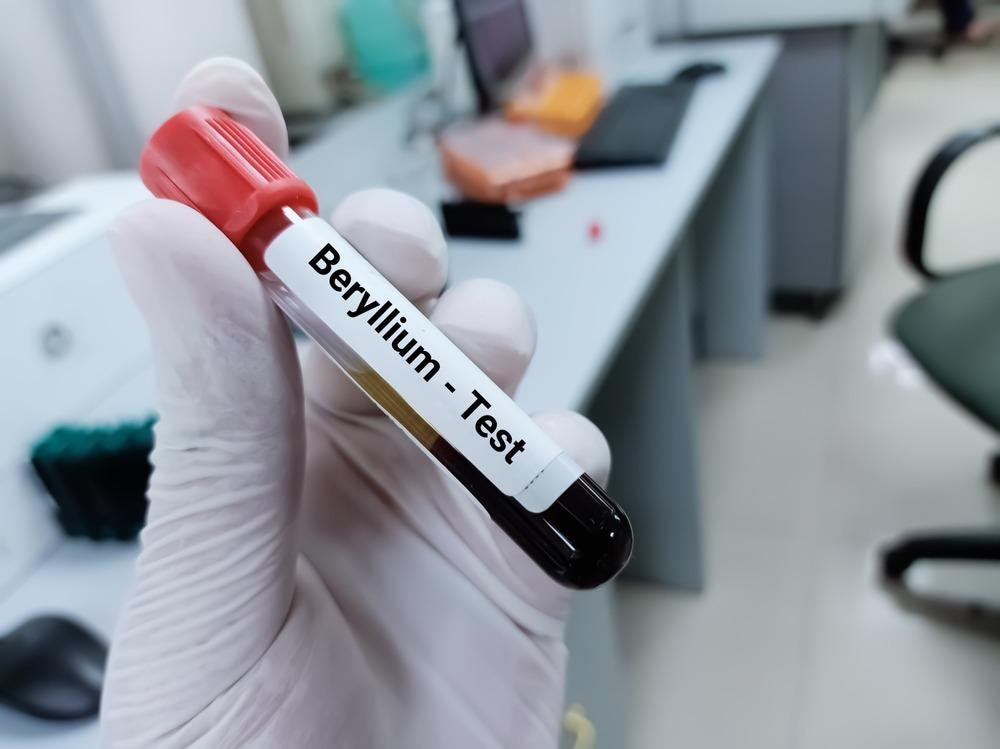Berylliosis, also known as acute beryllium disease, is a rare complication of metal poisoning. The different routes through which beryllium can enter and harm one's health include inhalation through the nasal passage and contact with the skin. Beryllium is a known carcinogenic metal with application in several industries like electronics and high-tech ceramics. It is a granulomatous disease that affects 2-5% of workers exposed to beryllium. Berylliosis is a lung disease with two forms- acute beryllium disease (ABD) and chronic beryllium disease (CBD).

Image Credit: Innovative Creation/Shutterstock.com
Causes and Symptoms
The fundamental cause of berylliosis is beryllium exposure. Beryllium is usually ingested through inhalation of beryllium fumes or dust, although it can also be absorbed through the skin. The soluble organic forms of beryllium are eliminated quickly, while the insoluble inorganic particles might stay in the body for years. People working in industries are exposed to a dangerous quantity of beryllium.
Metal machine shops, electronics, defense sectors, and beryllium extraction firms are among the industries that use a significant amount of beryllium. Ceramics, automotive, aerospace, jewelry, dental/alloy appliance, and computer are among the other industries. Also, there appears to be a hereditary predisposition in certain persons to develop severe CBD.
When the body is exposed to beryllium, T-cells, a type of white blood cell may generate a cell-mediated immune response. The immune system attacks the lungs or skin where the beryllium accumulates after each encounter. This can cause clumps of white blood cells involved in the immune system's response to foreign particles to form over time. Granulomas are clumps of these cells that can induce pulmonary fibrosis or the production of scar tissue in the lungs.
Acute berylliosis is an uncommon illness that occurs suddenly as a result of beryllium exposure. It is chiefly defined by significant pulmonary inflammation (pneumonitis). Common symptoms include sudden coughing, dyspnea, pharyngitis, tracheobronchitis, and rhinitis. In certain circumstances, other body parts, such as the skin or the eyes, may also be affected. The majority of the patients with acute berylliosis recover completely with no long-term problems. However, without immediate and adequate treatment, potentially life-threatening complications can occur.
Chronic berylliosis is a systemic disease characterized by an unusually hypersensitive immunological response to beryllium. In this case, the appearance of symptoms following initial beryllium exposure can range from 3 months to 30 decades. Patients with chronic berylliosis have the formation of abnormal nodules, called granulomas in the lungs and other tissues like lymph nodes, liver, and skin.
Scarring and thickening of deep lung tissues are also common symptoms of chronic berylliosis (interstitial pulmonary fibrosis). Dry coughing, dyspnea, chest pain, night sweats, anorexia, weight loss, and lymph node enlargement are some of the symptoms and findings linked with the condition. Reddened patches or little raised spots on the skin may also appear in some people. As the condition advances, affected people may have more severe lung damage, leading to laborious breathing even with minimal effort; liver impairment; and possibly life-threatening consequences.
Epidemiology
This hypersensitive condition develops in 2-5% population of beryllium-exposed workers. The progression to CBD has not been demonstrated to be reduced by limiting beryllium exposure. As ambient air levels of beryllium are generally quite low (0.03 ng/m3), the general public is unlikely to develop acute or CBD unless they reside very close to an industrial facility.
The death incidence ranges from 5 to 38%. Because of the development of preventative measures to decrease occupational exposure, acute berylliosis is rare. Nonetheless, the rate of chronic disease is similar to how it was when the condition was first documented in the 1940s.
Diagnosis and Treatment
The diagnosis begins with the examination of a person’s history of beryllium exposure. A positive blood or bronchoalveolar lavage (BAL) beryllium lymphocyte proliferation test (BeLPT) and granulomatous inflammation on lung biopsy are used to make a conclusive diagnosis of berylliosis.
The first step is to determine beryllium sensitivity, which is done using the beryllium lymphocyte proliferation test (BeLPT). Those who have been exposed to beryllium have two abnormal BeLPTs in their peripheral blood or one abnormal and one borderline result. Sensitization is also defined as having one abnormal BeLPT with fluid from a bronchial alveolar lavage. Bronchoscopy with bronchoalveolar lavage (BAL) is performed on patients who have a positive BeLPT result.
Finally, bronchoscopy is used to get a tissue biopsy, which is the final requirement for CBD diagnosis. The results of berylliosis on chest radiography are non-specific. Radiography findings are frequently normal early in the disease. Interstitial fibrosis, hilar lymphadenopathy, pleural abnormalities, and ground-glass opacities have been documented in the later stages of the disease. CT findings aren't always indicative of berylliosis.
As there is no cure for berylliosis, treatment aims to alleviate symptoms and slow the disease's course. Despite the lack of proof that avoiding beryllium exposure slows the progression of the disease, it is nevertheless considered a viable therapy option. Physical exams, pulmonary function testing, and radiography are used to monitor people in the early stages of the disease who have no lung function abnormalities or clinical symptoms.
Corticosteroids are the medications of interest for treating chronic beryllium disease. It usually takes a high starting dose and several months of treatment to observe symptom relief. Patients who do not react well to the steroids are given immunosuppressive drugs such as methotrexate and azathioprine. An interprofessional approach is required to aid reduce beryllium exposure in the workplace.
References:
Further Reading